Simone Mosca was a member of the group of (mostly Tuscan) sculptors that Antonio da Sangallo il Giovane assembled to work under him on the restoration of Santa Maria di Loreto in ca. 1530. This group also included Raffaello da Montelupo, and the three men subsequently retained their close links. Simone Mosca also worked closely with his son, Francesco Mosca, il Moschino.
Simone Mosca’s association with Orvieto probably began in 1535 (see below). According to Giorgio Vasari: “Simone, liking the society of the people of Orvieto, [subsequently] brought his family thither, in order to live in greater comfort; and then he set himself to work with a quiet and composed mind, being greatly honoured by everyone in that place”. In 1537, before an altar in the Duomo of Orvieto, Simone Mosca and Raffaello da Montelupto swore their allegiance to a brotherhood that also included a number of stone masons.
Giorgio Vasari concludes his account with the information that “in the year [1553], Simone died, at the age of 58, to the no small loss to [the Duomo] of Orvieto, in which he was buried with honour.
Work in the Duomo
In 1538, Simone Mosca became capomaestro at the Duomo. He was centrally involved in the start of its 16th century remodelling.
Cappella dei Magi (1535-46)
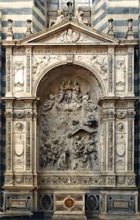
Antonio da Sangallo arranged for Simone Mosca to take over the project in 1535. According the Giorgio Vasari, “at the suggestion of Simone, his very dear friend Raffaello da Montelupo” to work on the central relief under the arch. A document records that Simone Mosca acted as host to Antonio da Sangallo when he made a short visit in 1536 to introduce Raffaello da Montelupo to the authorities.
The lower part of the relief was presumably complete by 1541, when Raffaello da Montelupo was back in Rome. It depicts the Magi adoring the Madonna and Child in a stable. The main figures are in deep relief: a number of camels, including one ridden by a monkey, are drawn in shallow relief in the background. According to Giorgio Vasari, Francesco Mosca, il Moschino (see below) subsequently executed the group of angels in the upper part of the central relief, the relief of God the Father in the pediment, the angels in the lunette and the Victories to the sides of it. The chapel itself was finally completed in 1546.
Cappella della Visitazione (1547-54)
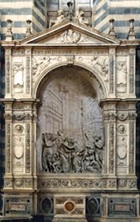
Vasari added that the relief of the Visitation at its centre was commissioned from Simone’s son, Francesco Mosca, il Moschino. The young Ippolito Scalza seems to have worked as an assistant on the project.
Monument to Orsino and Rodolfo da Marsciano (1522-45)
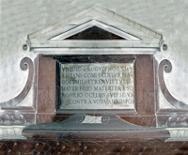
Michele Sanmicheli was commissioned to execute this monument on the right wall of the Cappella del Corporale in 1522, but the work was still in the design phase in 1524. Further delay arose in 1527, when the money that had been bequeathed to pay for the monument was "borrowed" as a contribution to the fortification of the city during the tense period before the sack of Rome. Simone Mosca completed it in 1544-5.
[Who were the deceased ???]
Tabernacles (ca. 1557)

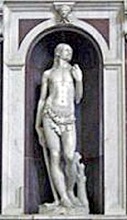
Virgin Adam
According to Giorgio Vasari, “[Simone Mosca] having then returned to Orvieto, arrangements were made to erect after his designs, in the cross at the head of the church, two great tabernacles of marble, works truly graceful, beautiful, and well-proportioned, for one of which Raffaello da Montelupo made in marble a nude Christ with the Cross on His shoulder in a niche, and for the other [Francesco Mosca, il Moschino] made a St Sebastian, likewise nude”.
These two tabernacles, for which a payment was recorded in 1555, now contain figures by Fabiano Toti:
-
✴niche to the right of the entrance to the Cappella del Corporale, which originally housed the figure of the Risen Christ that Giorgio Vasari attributed to Raffaello da Montelupo, now houses a figure (1580-2) of the Virgin.
-
✴The niche to the left the entrance to the Cappella Nuova, which originally housed the figure (1567) of St Sebastian that Giorgio Vasari attributed to Francesco Mosca, il Moschino (which apparently also involved input from Ippolito Scalza) now houses a figure (16th century) of Adam.
Completion of Pozzo di San Patrizio (1536)
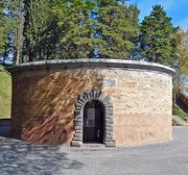

Antonio da Sangallo il Giovane began the construction of what became known as the Pozzo di San Patrizio soon after Pope Clement VII took refuge in Orvieto in December 1527. Work below ground was largely complete by the time that Pope Paul III visited Orvieto in 1536.
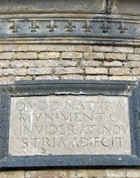
Restoration of Palazzo Soliano ca. 1540
The Commune took over Palazzo Soliano in ca. 1540 and arranged for its partial demolition and rebuilding. Pope Paul III financed some of this work, carried out by Simone Mosca.
Palazzo Gualterio (16th century)
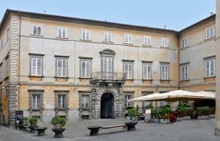
A design for Palazzo Gualterio by Antonio da Sangallo il Giovane survives in the Uffizi Gallery, Florence. It was probably built to this design by Simone Mosca: according to Giorgio Vasari, he “executed ... the ground plan and facade of the house of Messer Raffaello Gualtierio, father of the Bishop of Viterbo, and of Messer Felice, both noblemen and lords of great excellence and reputation”. (Raffaele and Felice Gualterio were respectively the son and nephew of Sebastiano Gualterio, who was bishop of Viterbo in the period 1551-66).
Palazzo Monaldeschi (16th century)
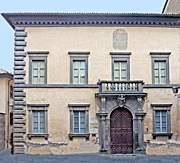
According to Giorgio Vasari, Simone Mosca executed “the ground plans of some houses for the honourable Counts della Cervara”. These probably included Palazzo Monaldeschi, which was commissioned by Sforza Monaldeschi della Cervara. The design is unusual for Orvieto in that the palace has an internal courtyard surrounded by a loggia.
The historian Monaldo Monaldeschi, who was the brother of Sforza, recorded in 1584 that the palace was extended after the reign of Pope Pius IV (died 1565). Ippolito Scalza, who designed ten windows (1572) and the ceiling of its living room (1574), presumably brought the project to completion.
Perugia
The Pope then causing the fortress to be built in Perugia where there had stood the houses of the Baglioni, Antonio da San Gallo, having sent for Mosca, gave him the charge of making the ornaments; where there were executed after his designs all the doors, windows, chimney pieces, and other suchlike things, and in particular two large and very beautiful escutcheons of his Holiness. In that work Simone formed a connection with M. Tiberio Crispo, who was Castellan there; and he was sent by M. Tiberio to Bolsena, where, on the highest point of that stronghold, overlooking the lake, he arranged a large and beautiful habitation, partly on the old structure and partly founding anew, with a very handsome flight of steps and many ornaments of stone. Nor did any long time pass before Messer Tiberio, having been made Castellan of the Castello di Sant' Angelo, caused Mosca to go to Rome, where he made use of him in many matters in renovating the apartments of that castle; and, among other things, he caused him to make over the arches that rise over the new loggia, which faces towards the meadows, two escutcheons of the above-named Pope in marble, which are so well wrought and perforated in the mitre, or rather, triple crown, in the keys, and in certain festoons and little masks, that they are marvellous.
Read more:
F. Piagnani and L. Principi, “La Scultura del Cinquecento in Orvieto”, in
C. Benocci et al. (Eds), “Storia di Orvieto: Quattrocento e Cinquecento” (2010) Pisa, Volume II, pp 585-636
T. Verellen, “Patterns of Patronage: Antonio da Sangallo the Younger and the Setta of Sculptors”,
in F. Kent et al. (Eds), “Patronage, Art and Society in Renaissance Italy”, (1987) Oxford
Return to Art in: Orvieto.
Return to “Foreign” Sculptors in Umbria.



